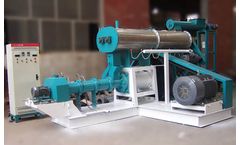Paddy Field Articles & Analysis
20 articles found
Puffed Floating Fish Feed Has A Wide Application Prospect In terms of breeding methods, floating fish feed can be used in pond fish farming, paddy field fish farming, cage fish farming, and factory fish farming. Especially for pond fish and paddy fish farming with relatively low culture density, floating fish feed is more advantageous than other ...
High nitrogen (N) leaching from irrigated agricultural soils is the result of N input exceeding soil N load capacity (NLC). A simple approach was developed in this research to assess the NLC of paddy soils in the southern Taihu Lake watershed. Paddy soils were classified into four types (Submergenic, Illuvium, Gleyed, and Percogenic) and 28 soil samples representing all four types were ...
It was found that the SWAT model identified the sub-catchments which not only receive high rainfall but are also densely populated with high agricultural production from dry fields and paddy fields, which are large users of pesticides and chemical fertilizer, as the primary source areas for nutrient exports. ...
Their conclusion is that the human impact of methane and nitrous oxide emissions – from such sources as dairy farms, rice paddies and wheat fields – far outweighed the terrestrial uptake of carbon dioxide. ...
The results showed that the proportion of nutrients from compost/manure applied to paddy fields decreased from 85 to 41% for both N and P between 1980 and 2010. ...
The results showed that the proportion of nutrients from compost/manure applied to paddy fields decreased from 85 to 41% for both N and P between 1980 and 2010. ...
Determining the optimal times of opening and closing valves based on the factors directly influencing the volume of the water in paddy fields is also of great importance. To meet the above conditions and by using linear and non-linear programming, two different models are developed in this article, with the purpose of reducing the time period of plowing and ...
Because of the prevalence of algae in rice paddy fields, they will be exposed to Bacillus thurigiensis (Bt) proteins released from Bt protein‐expressing genetically engineered rice. ...
In the Albufera (València) region of Spain, rice has been farmed for nearly 500 years. Post-harvest flooding of rice fields has become an integral element of wetland refuge for migratory birds. ...
Leave enough working space for the transplanter to avoid the collision of the paddy transplanter and the ridge of the paddy field. Supply the seedlings in the seedling box timely and do not transplanter the seedlings when the machine is across the ridge of the field. ...
A rice transplanter is a specialized transplanter widely used to plant rice seedlings in the paddy field. The machine can both improve the efficiency and quality of rice transplanting. However some questions are claimed by the clients when using the paddy transplanter and we found that most of the problems are caused by the unproper use of the ...
The objectives of this were: 1) to study the effects of various wastewater treatment levels on crop growth and yields; 2) to determine the pollution loads from wastewater applications to paddy fields, and explore potential health hazards; 3) to investigate the treatment efficiencies of three different levels of ...
Panikakuwa, Kakuwa, Miabao, Dalbao, Maguribao, Negheribao, Panidhan, Bhubao, Amana and Happybao) collected from different paddy growing fields of Dhemaji district, Assam, have been taken into study. ...
Accurately measuring soil organic matter content (SOM) in paddy fields is important because SOM is one of the key soil properties controlling nutrient budgets in agricultural production systems. ...
When the amount of arsenic in the groundwater is high, it has been observed that the levels of arsenic in agricultural land soil and plants are correspondingly high. Arsenic concentration in paddy field soil and plants is higher, compared to other agricultural field soil and plants. Pond water is safer for cultivation compared to irrigated ...
Plants were grown in 12-L pots during the 4 yr, and in a paddy rice field during the 2006–2007 growing season. Coefficients necessary to run the Streck model, the WE model, and the phyllochron model were estimated with data from five sowing dates of the 2003–2004 growing season and the models were evaluated with independent data from the other three growing ...
SOC sequestration could be increased at the expense of increasing the amount of non-CO2 GHG emissions; however, soil testing, synchronized fertilization techniques, and optimum water control for flooding paddy fields, among other things, can reduce these emissions. Since increasing SOC may also be able to mitigate some local environmental problems, it will be ...
Two water management practices, an intermittent irrigation scheme using automatic irrigation system(AI) and a spillover-irrigation scheme (SI), were compared for the fate and transport of commonly used herbicides, mefenacet (MF) and bensulfuron-methyl (BSM) in experimental paddy plots. Maximum mefenacet concentrations in paddy water were 660 and 540 µgL−1 ...
The average soil organic matter (SOM) content of paddy fields was higher than that of normally-cultivated soils in Piedmont, and the C/N was higher, owing to the low mineralization rate in waterlogged conditions. The SOM content was in relation with the management of the crop residues, as the tradition of burning straw after harvest was still widespread on 65% ...
This paper evaluates the constitution, significance and limitations of direct payment policy to farmers in hilly mountainous areas (i.e., Japan's less-favoured areas), where small-sized terraced paddy field farming is predominant. A significant period of depopulation and the successive aging of the rural society have resulted in the decline of farming output and ...








